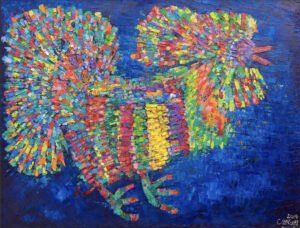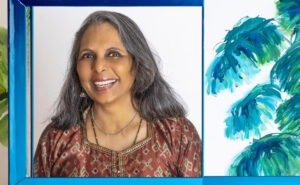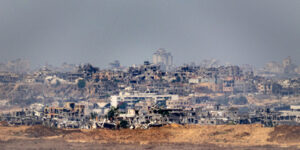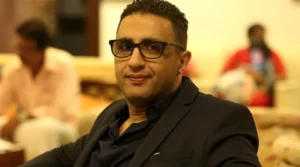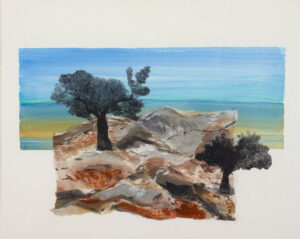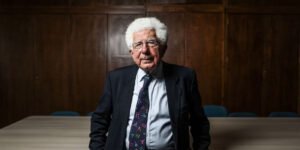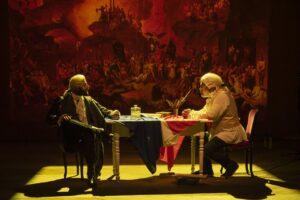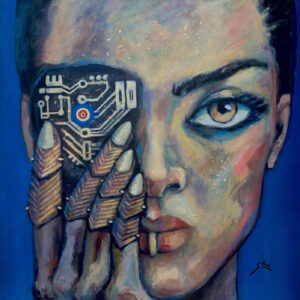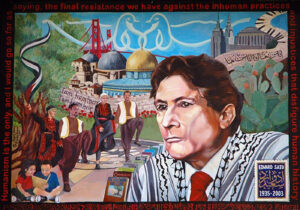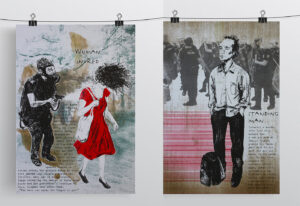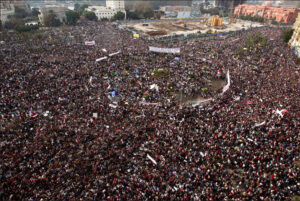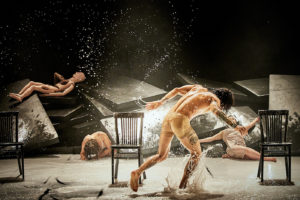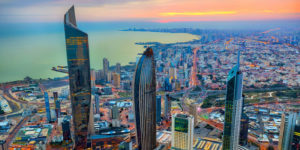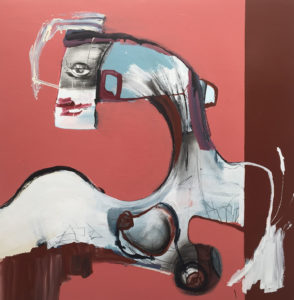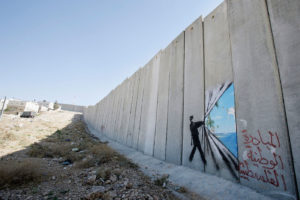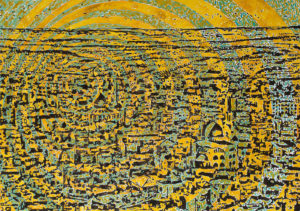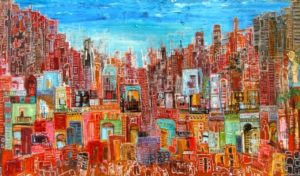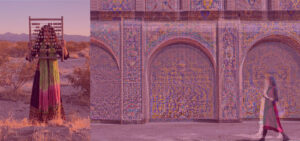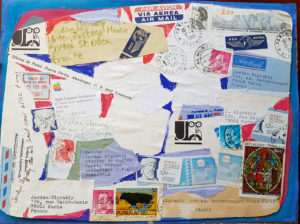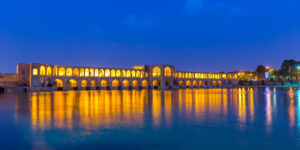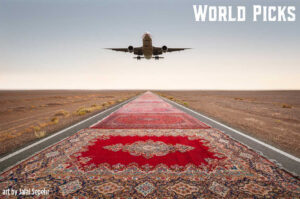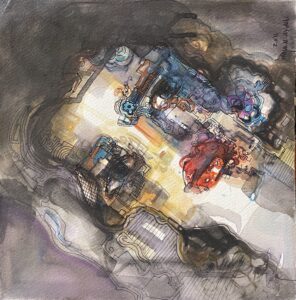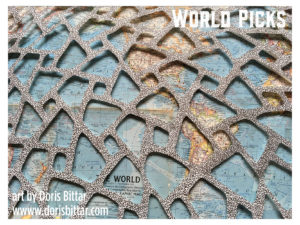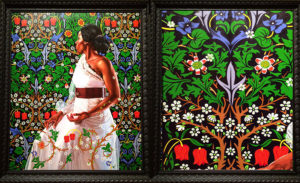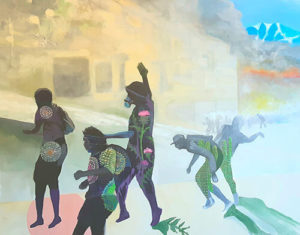“The World Through a Sieve,” Rand McNally map, security envelope pattern, 22″ x 30″ (55.9 x 76.2″ cm) 2017 (courtesy Doris Bittar).
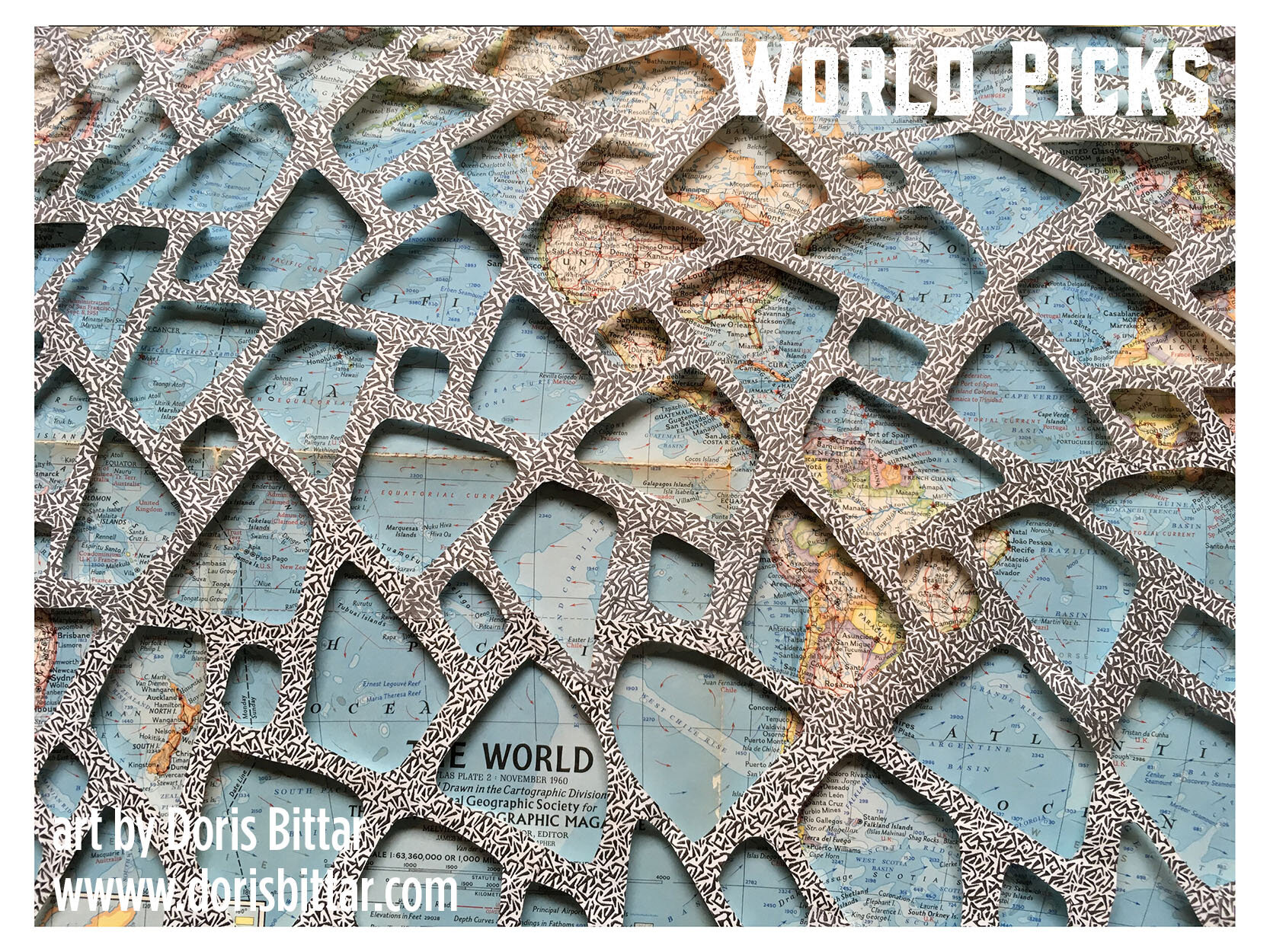 <
<
Got an event, book, film, conference or anything else you’d like to recommend? Drop us a line.
All listings are online, unless otherwise noted.
Published in May — Iberian Moorings: Al-Andalus, Sefarad and the Tropes of Exceptionalism
Iberian Moorings available from UPenn.
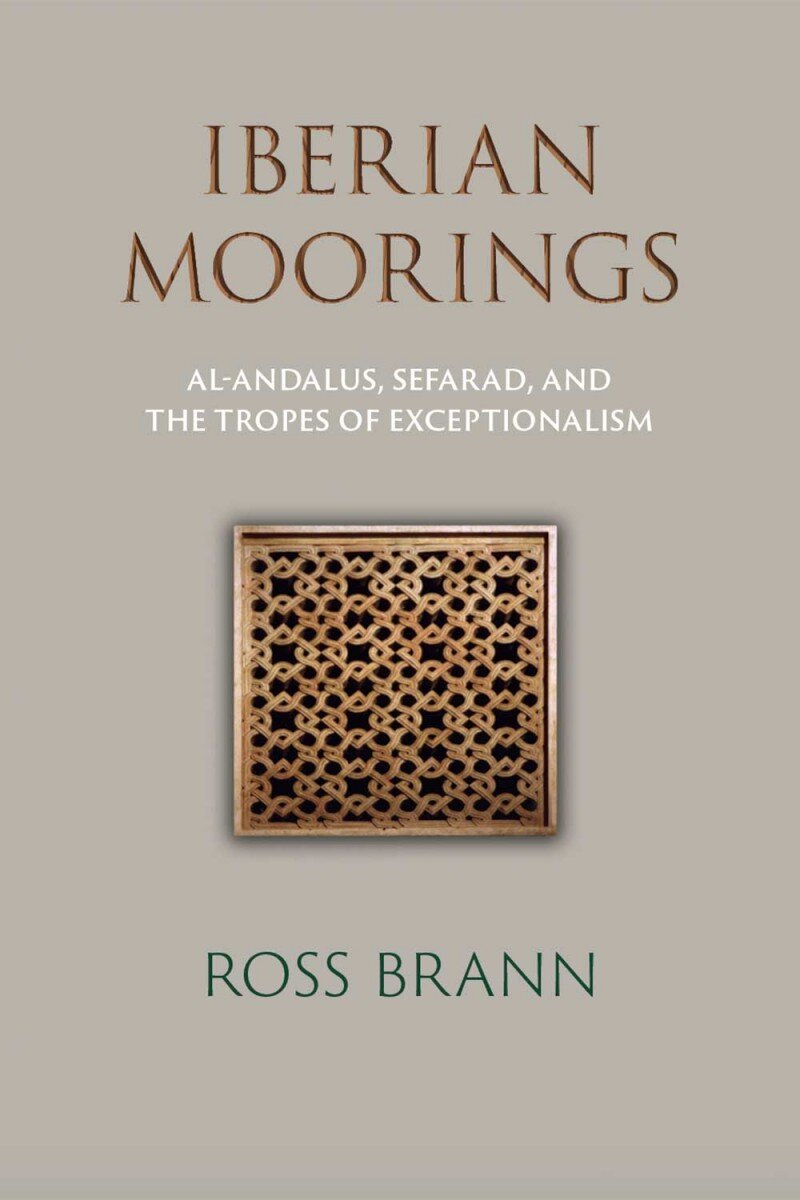 <
<
An accomplished Cornell University authority on Judeo-Muslim relations, Ross Brann has won praise for his new book, Iberian Moorings: Al-Andalus, Sefarad and the Tropes of Exceptionalism (University of Pennsylvania Press). He explores within its pages the rich interplay of culture, politics, art, philosophy, music and even religion between Jews and Muslims in 10th to 13th century Spain.
Was this period truly a golden age? It likely looks so judging from the intercommunal woes of May 2021. Brann’s uniquely synoptic view – say reviewers – shows two narratives each championing a high watermark in their respective civilisations. Nor can one ignore the cross-fertilizing role of Christians who called Spain Hispania.
Brann’s project germinated in 1992, the quincentenary of 1492, when Christian Spain expelled its Jews, crushed the last Muslim outpost, and sent Columbus off to “discover” the New World. Yet Muslim Al-Andalus and Jewish Sefarad outlived political extinction to thrive as vibrant tropes. True, their description of unparalleled social tolerance might reflect nostalgia, as Brann concedes. Or even disguised chauvinism. But for all the mythologizing, it surely represents a vision to emulate in our troubled times.
15 May – 25 July — Splendour of the Sunset: Iran of the Qajar Era, State Museum of Oriental Art, Moscow, Russia
For 136 years the Qajar dynasty ruled Persia as the nation struggled to modernise and unify. At the same time the rulers desperately fended off two predatory empires, the British and Russian, until in 1925 they fell to a new dynasty, the Pahlavis. Yet they left behind a remarkable trove of art that fused a rediscovery of pride in Iranian identity with a desire to emulate the best of the West.
Notable examples of this cultural flowering are now on display in Splendour of the Sunset: Iran of the Qajar Era. The exhibition is hosted until 25 July by the State Museum of Oriental Art in Moscow, and features some 300 paintings, ceramics, weapons, carpets, glassware and manuscripts, historical documents and photographs. Most have never been seen in public before. Each room is devoted to another aspect of late 18th to early 20th century Iran: war and hunting, politics, fine art, religion, and daily life. The art itself ranges from naïve popular artefacts to precious and beautifully crafted objects imbued with mythological references.
Besides its changing exhibitions, the State Museum has permanent galleries for Chinese, Japanese, Korean, Vietnamese, Caucasian, Indian, Buddhist and other Iranian art. The newly established Soviet Union founded the museum in 1918 as the first Russian effort to properly acknowledge the former empire’s Central Asian nations. So if you can prise your eyes from the pictures on the wall, the building itself, a gracious 19th century edifice, offers aesthetic pleasures of its own.
19 May to 26 September — Divas: D’Oum Kalthoum à Dalida at the Institut du Monde Arab, Paris
Listen to MARSM mixtapes for free on SoundCloud.
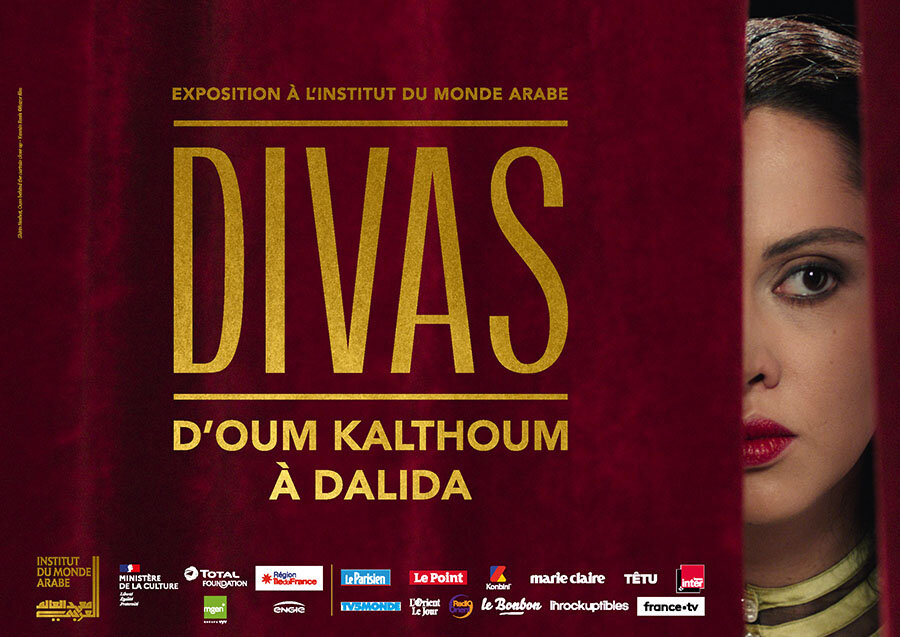 <
<
Showcasing an eclectic selection of music arranged in sequences of unforeseen sonic analogies, this collective mix was put together by Basma, who is of Nubian Sudanese descent and is based in London. She hosts the Khartoum Arrivals show on NTS Radio where she likes to tap into memories tied to old Sudanese love songs.
For decades, her voice sang the soundtrack to millions of lives across the Middle East. Now the Institut du Monde Arabe celebrates the stage and silver screen heritage of Umm Kulthum and other Arab chanteuses with an exhibition appropriately called Divas: D’Oum Kalthoum à Dalida.
Opening on 19 May and lasting till 26 September, Divas already features several tempting amuses bouches in the form of short videos on YouTube, with such alluring titles (in English translation) as Militant Divas and Pioneers of Arab Feminism. The website also comes replete with evocative film posters, going back to 1927 with Behidja Hafez in Laila bint al-sahara [Laila, la fille du desert].
These divas were no shrinking violets or hapless sex objects: Hafez, for instance, was Laila’s central character, director and co-producer. Tahiyya Carioca, the occasionally risqué artiste of 1930s films, was also, we learn, an ardent communist, who spent three months in prison after Gamel Abdul Nasser took power. Dalida, a former Miss Egypt in her leopard-skin bikinis, later highlighted social inequities in her many films; while Hoda Chaaraoui founded a salon in 1908 that championed free thought and female emancipation.
For her part, Samia Gamal created a new dance form blended from Arab, classical Western and Latin American styles, and appeared in a bewildering 50 films during the 1940s and 1950s. Asmahan, daughter of a Druze princess, not only possessed an unparalleled voice but also risked her life spying for the Allies in World War II. Warda began singing cabaret in Paris, but soon was moving millions with paeons to the Algerian revolution and donated concert takings to the anti-colonialist FLN militia.
Equally defiant of conservative norms, Layla Mourad – born Lillian Zaki Mourad Mordechai to a Jewish family – debuted at 15 in the 1932 film, Al-Dahaaya (The Victims). She charmed a generation of cinema-goers with her singing and comedic acting, and even ousted Umm Kulthum as “voice of the revolution” in 1953… until jealous rivals called her an Israeli spy.
While top Egyptian military figures quashed the rumors, she never reached the heights of the contralto, Umm Kulthum. The “Voice of Egypt” transformed the soundscape of popular Arab music with performances that often lasted for more than an hour per song. In 1975 her funeral brought some four million mourners onto the streets of Cairo. Unwilling to let her go, Egyptians to this day throng to concerts where she “appears” in hologram form.
Divas will charm viewers with its evocation of a golden age in modern Arabic culture. But there is more to the exhibition than nostalgic indulgence. Rather, it reminds one that even a century ago, powerful Arab women offered a sense of individualism, and a vision of hope, to a troubled region.
22 – 30 May, Elia Suleiman Retrospective + Talkback, Streaming for Free in the US, Canada and Palestine
The Arab Film and Media Institute presents a showcase the work of celebrated Palestinian filmmaker Elia Suleiman as part of the Arab Film Series online. Throughout his career, Elia directed four feature films, Chronicle Of A Disappearance (1996), Divine Intervention (2002), The Time That Remains (2008), and It Must Be Heaven (2019), which opened the 23rd Arab Film Festival in 2019.
All four films will be available to stream for FREE, and you will be able to watch them now through May 30. Please note that films are available for viewing within the United States, Canada and Palestine. Free with RSVP / Suggested donation $5.
There will be a live online talkback with filmmaker Elia Suleiman on May 23, at 12 pm Pacific with AFMI’s Yasmina Tawil.
The Arab Film Series is a monthly program of films and discussions from the SWANA region and its diasporas, presented by the Arab Film and Media Institute in partnership with the Arab American National Museum and ArteEast.
RSVP.
25 May — The GCC at 40: Prospects for the future, Chatham House, London
Created in the midst of the ferocious Iran-Iraq war of 1980-88, the Gulf Co-operation Council celebrates forty years of existence on 25 May. To mark that occasion Chatham House/ Royal Institute of International Affairs is hosting a conference which will be livestreamed on the MENA Programme Facebook page.
The event hopes to cover everything from the 1990 Gulf War and 2011 Arab Spring to the Al Ula agreement of January this year, ending the tussle between Saudi Arabia and Qatar. Participants are Bader Al-Saif of the Carnegie Middle East Center; Kristian Coates Ulrichsen, Middle East Fellow at the Baker Institute; and Kristin Smith Diwan of the Arab Gulf States Institute in Washington; with Sanam Vakil, Deputy Director of MENA Programme, Chatham House, as moderator.
Five unique districts, connected by a 20km-long public realm called the Wadi of Hospitality, will protect 200,000 years of natural and human history across the 20km-long core historical area of AlUla, a unique cultural landscape located in north-west Arabia, encompassing a wadi (seasonal river valley) and culminating in the Nabataean city of Hegra, a UNESCO World Heritage Site. <
<
Announced in May — Journey Through Time Masterplan, Al-Ula, Saudi Arabia
Al-Ula has been “an oasis of unique culture, heritage, nature and community” for millennia in what is now Saudi Arabia. This month Riyadh said it would invest billions to transform the vast area into a hub for tourists and home to 135,000 by 2035. Officials vow to sustainably preserve Al-Ula’s treasures as a living museum, according to a plan dubbed Journey Through Time.
People first settled in Al-Ula in the sixth century BC. The walled town straddled an incense route that both the Old and New Testaments allude to. Besides archaeological treasures such as its Nabatean theatre and pre-Islamic citadels around Al-Hegra Old City, Al-Ula is renowned for its arid natural beauty. A resort called Shabaan will probably house the rare Arabian leopard and other precious flora and fauna. Phase one is due for completion in two years. For now, the curious can visit Al-Ula’s Maraya Valley to marvel at the world’s largest mirrored building.
[image caption] Five unique districts, connected by a 20km-long public realm called the Wadi of Hospitality, will protect 200,000 years of natural and human history across the 20km-long core historical area of AlUla, a unique cultural landscape located in north-west Arabia, encompassing a wadi (seasonal river valley) and culminating in the Nabataean city of Hegra, a UNESCO World Heritage Site.
Until June 12 — Exhibition Light Upon Light: Light Art Since The 1960s at the King Abdullah Financial District Conference Center, Al Aqiq, Riyadh 13511, Saudi Arabia
Still from Alia Ali’s film Mahjar.
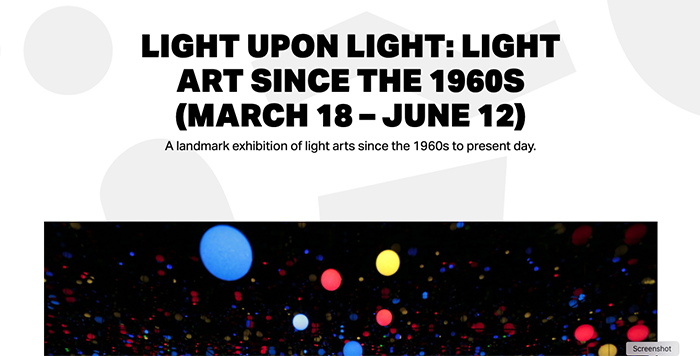 <
<
While in many international cities, museums are closed under lockdown rules, the exhibition Light upon Light is open to the public and online. Thirty international artists play with, reflect and generate light in immersive and interactive installation, video and sculpture. The Japanese artist Yayoi Kusama, who loves polka dots, dazzles with Infinity Mirror Room – Brilliance of Souls, 2014. For the installation Mitochondria: Powerhouses, 2021, Saudi physician and artist Ahmed Mater uses a Tesla resonance transformer coil and creates a flow of high voltage and alternating current electrical lightning strikes, which melt sand and form glass sculpture.
Another Saudi artist, Manal Al Dowayan, takes a less visceral approach with the words in poetic light: Nostalgia Takes Us to the Sea But Desire Keep Us from the Shore, 2010. Al Dowayan was in conversation with British Museum curator Venetia Porter and artists Newsha Tavakolian, from Iran, and Laura Boushnak, from Palestine, and spoke about the fast past of change taking place in her country, an event available on YouTube.
Light upon Light was curated by Susan Davidson, formerly from the Guggenheim Museum and Saudi curator Raneem Zaki Farsi. It is the first edition of Noor Riyadh, the first city-wide public art program; and Art Riyadh, a national public art initiative, new projects that coincide with Vision 2030 to reduce Saudi Arabia’s dependency on oil and diversify its economy through tourism and culture. Despite the religious connotations of the exhibition’s title Nûr ‘alâ Nûr, in Arabic, the high-end art project has been criticized for “art-washing” the country’s dire human rights record.
Through June ‘21 — Revival, Saida’s Hammam Al Jadeed, Saida, Lebanon
Artist Tom Young has teamed up with Saida’s Said Bacho to paint a series of 60 canvases timed with the revival of Saida’s 300-year-0ld Hammam Al Jadeed in the city’s old town. For those unable to visit the exhibition, both within Lebanon and around the world, the exhibition is available online as a virtual tour.
As well as a freely accessible art exhibition and museum onsite, there are documentary film screenings (see here and here) about the history of the hammam, concerts, theatrical performances and historical lectures on site.
Hammam Al-Jadeed will continue to be a site of education: a series of art workshops are planned for local school children, university students, orphans and refugee children on Wednesday and Friday mornings.
Israeli bombing of Saida 1982, oil on canvas, 100cm x 80cm.jpeg (courtesy Tom Young)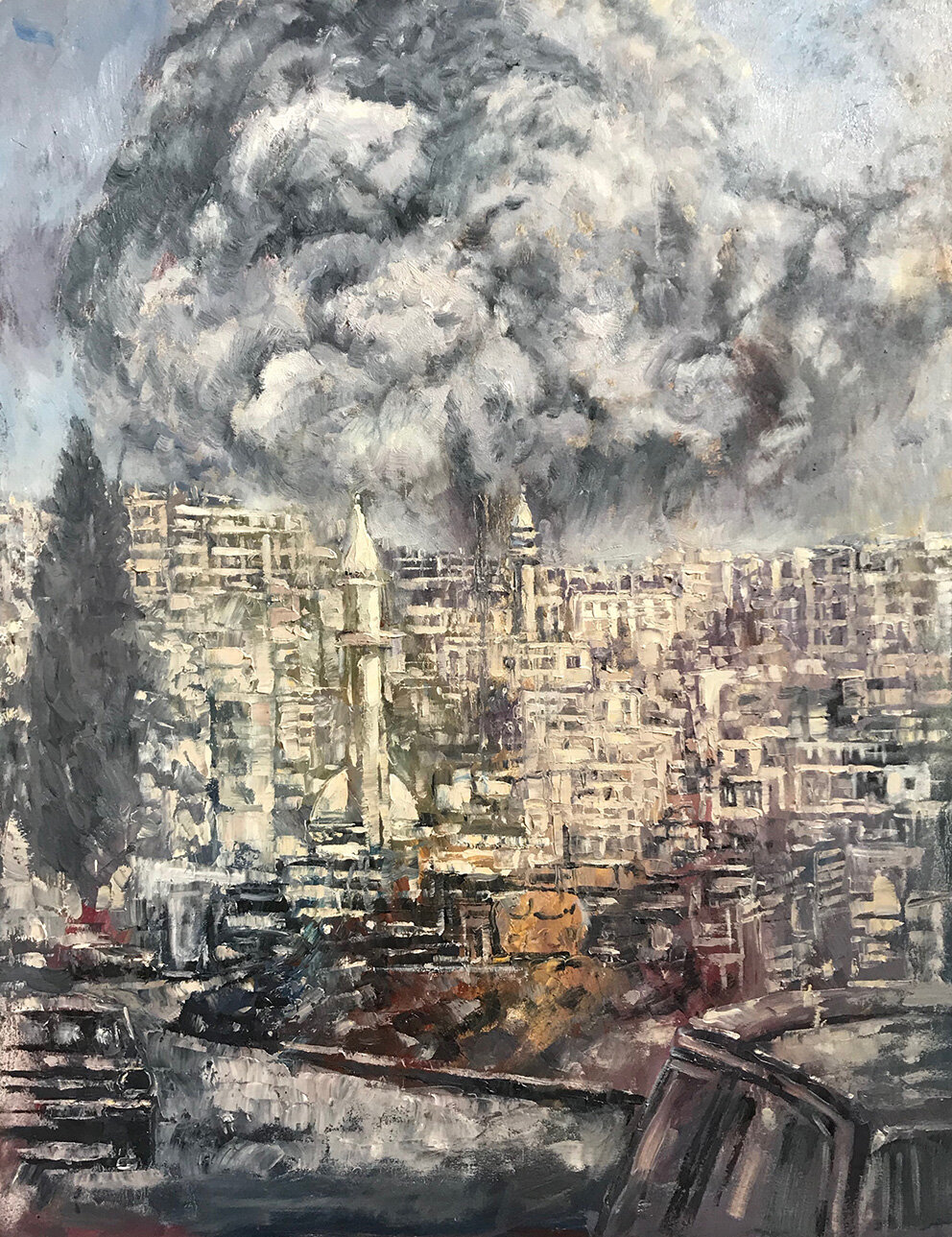 <
<
Hammam Al Jadeed is a beautifully preserved 18th-century bathhouse situated in the heart of Saida’s old souq. It is the second largest hammam in Lebanon. What was once a thriving center of community exchange and cleansing for people of all three Abrahamic religions was abandoned in the late 1940s; the demand for public hammams decreased due to water supply reaching peoples’ homes. The building has since been a carpentry workshop, during which time the splendid original features were all boarded up and plastered over. The hammam sustained further damage from bombing during the Civil War.
It had remained an undiscovered gem until Saida born and bred, Said Bacho, Founder and Chairman of Sharqy Foundation for Cultural Development and Innovation, acquired it in 2018, having already acquired and renovated the adjoining furnace building in 2009. Bacho and his team of skilled craftsmen set about the delicate process of uncovering and preserving traces of its stunning original architectural features. The 300-year old Hammam Al-Jadeed opened again to visitors during Ramadan in May 2019 after 70 years of closure, as a historic attraction site with local young men and women professionally trained to guide multi-national visitors around.
Inspired by a visit to internationally-renowned British artist Tom Young’s on-site exhibition at the Grand Hotel in Sofar in 2018 and in line with Sharqy Foundation’s mission to inspire and empower cultural development and innovation, Bacho invited Young to visit Hammam Al-Jadeed in May 2019 and see if he could bring the place alive as a center of art, culture, historical learning and education.
Not only was it a place where local multi-religion multi-ethnic communities would meet and mix, it was also used to hold infamous wedding ceremonies. By reviving these stories through the lens of the present, it is hoped that exhibition can celebrate what different communities have in common, and inspire us going forward.
Throughout May and on till 4 June — Taking Shape: Abstraction from the Arab World, 1950s–1980s, McMullen Museum of Art, Boston College, USA
Ahmed Cherkaoui (Boujad, Morocco, 1934–Casablanca, Morocco, 1967), ‘Les miroirs rouges (Red Mirrors).’ Oil on jute; 1965.
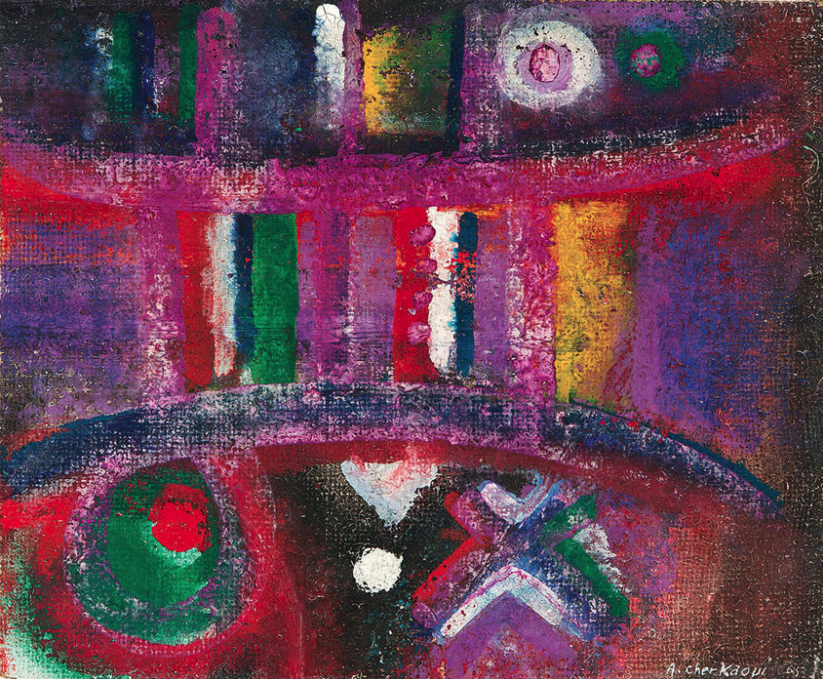 <
<
Long neglected by Western aesthetic aficionados, the once-vigorous genre of Arab abstract art gets some overdue recognition at the Boston College’s McMullen Museum of Art.
Free virtual tours of the exhibition take place every Friday till 4 June, and you can register via this link. Curated by Suheyla Takesh and Lynn Gumpert, the exhibition itself remains open till 13 June and features nearly 90 works by artists from states including Algeria, Egypt, Iraq, Jordan, Kuwait, Lebanon, Morocco, Palestine, Qatar, Sudan, Syria, Tunisia, and the UAE. “Arab” may be a misnomer, however, as the artists comprise people of Amazigh (Berber), Armenian, Circassian, Jewish, Persian, and Turkish descent.
What unites them is a “bid for authenticity in a time of decolonisation.” The art displayed shows a passionate desire to express local forms while asserting individuality; to mine the potential of Islamic geography and Arabic script, but at the same time to engage with a world beyond the Middle East. All material comes from the collection of the Barjeel Art Foundation based in Sharjah, UAE.
May 22 & 29 May + 5 & 12 June — Splendors of Spain, Museum of Islamic Art, Doha, Qatar
Also singing the praises of Muslim Spain, Qatar’s Museum of Islamic Art offers four Zoom webinars that explore medieval Iberian creativity. The first session teaches basic Andalusian Geometry and Mosaics. The second shows how to replicate Moroccan-style Zouaq wood-painting from Seville. Session three is devoted to two classic items: the exquisitely patterned Dor Hind, a ceramic deer housed at the MIA and created c. 950-1010 at Madinat al-Zahra, near Córdoba; and Manafi al-Hayawan, a 12th century encyclopaedia of animals. Lastly, the 12 June session, Majestic Nasrid Textiles, aims to have students recreate the astonishing motifs of Moorish Grenada.
Each session builds on the previous, from beginners to advanced. A chance to understand the artistic grammar that still influences Arab and Maghrebi art – and still makes jaws drop!
9 June, 2021 — Tea and Tafreez with Wafa Ghnaim — Museum of the Palestinian People, Washington DC
At a time when grim politics has once more wrought havoc in Palestine and Israel, here is a chance to celebrate the timeless beauty of Palestinian culture and heritage. On 9 June the Museum of the Palestinian People in Washington DC will host a virtual Tea and Tatreez and talk with resident embroidery advocate, artist and author, Wafa Ghnaim. The American-born Wafa began her venture in 2015, inspired by the example of her mother who grew up in a Syrian refugee camp and taught the ancient craft. You can learn more about tatreez, the Palestinian art of embroidery, some of whose symbols date back to China of 5,000 BC, here.
The MPP began life as a travelling exhibition in 2015 and found a permanent home in DC in 2019. Christopher Khoury, son of an American-Palestinian artist whose work features in MPP’s permanent collection, said after its official launch “So much of our destiny has been dominated by the machinations happening in our capital. Now is as good a time as ever to begin turning that logic around and reclaiming our narrative.”
Originally MPP’s raison d’etre was to speak of the Nakba, the enforced Palestinian exodus of 1948. Now it has expanded its brief to offer a showcase to Palestine’s rich culture, to share Palestinian stories through historic artifacts, personal narratives and art, to connect Palestinians across the diaspora, and to partner with likeminded organisations to reach a wider audience. In short, in the words of MPP’s US-based founder Faisal Saleh Faisal, to “demonstrate Palestinian unity in the face of the challenges Palestinians face.”
Past exhibitions have included Re-Imagine A Future, with work by artists Manal Deeb, Ahmad Hmeedat, Dalia Elcharbini, Mohammed Musallam and Haya Zaatry. The museum reopened on 1 May after a long lockdown-imposed hiatus, though “visitors” from outside the States can still enjoy its delights via virtual tours. Explore online a 360-degree museum tour, art by Palestinian women, interactive maps showing where Palestinians live today, biographies under the rubric Making their Mark, and Intersections: Palestinian and African American Art for Social Justice. You can also discover West Bank-born Jordanian-based Nawaf Soliman’s amazing calligraphic works in Cities of the Heart, which in the previous link subdivides into special focuses on Haifa, Jerusalem, Bisan, Jaffa, Ramallah, Nablus, Bethlehem and Tiberias.
June to October, 2021 — Wir Sind Von Hier. (We Are from Here.) Turkish-German Life, 1990. Photographs by Ergun Çağatay, Ruhr Museum, in Essen, Germany
For the 60th anniversary of the 1961 recruitment agreement between Bonn and Ankara, the Ruhr Museum will be showing We Are from Here. In 1990, the renown Turkish photographer photojournalist and author Ergun Çağatay (1937-2018) toured Hamburg, Cologne, Werl, Berlin and Duisburg and took thousands of photographs of first and second generation Turkish “guest workers,” many of whom stayed and took on German citizenship. We Are from Here., curated by art historian and critic Dr. Peter Stepan, makes Çağatay’s photo reportage available to international audiences for the first time.
The exhibition’s 120 images reveal the diversity of the Turkish-German world, through people’s living-rooms, mosques, grocery stories and jobs. Taken between the fall of the Berlin Wall and German reunification, the images bring to mind a time of upheaval in Germany, during the country’s transformation into a multicultural society. The exhibition also includes eight video interviews with contemporary witnesses and a media installation.
We Are from Here. is a joint German-Turkish project, funded by the German Foreign Office, the RAG Foundation and the Alfried Krupp von Bohlen und Halbach Foundation, under the patronage of Germany’s Michelle Müntefering, Minister of State for International Cultural Policy. The exhibition will tour German and Turkish cities (Essen, Hamburg, Berlin, Istanbul, Ankara, and Izmir). A bilingual German and Turkish catalogue and a magazine, which examines immigration and German society, accompany the exhibition.
Until September 12, 2021, Exhibition EPIC IRAN Epic Iran at the Victoria & Albert Museum
The Epic Iran exhibition explores 5,000 years of Persian art, design and culture though sculpture, ceramics and carpets, textiles, photography and film. The historic objects and artworks reflect the Iran’s vibrant historic culture, architectural splendors, the abundance of myth, poetry and tradition, and the evolving, self-renewing art and culture of today. From the Cyrus Cylinder and intricate illuminated manuscripts of the Shahnameh to ten-meter-long paintings of Isfahan tile work, Shirin Neshat’s two-screen video installation Turbulent, and Shirin Aliabadi’s striking photograph of a young woman chewing bubblegum, the exhibition presents an overarching narrative of Iran from 3000 bc.
It covers: the Land of Iran; Emerging Iran starting in 3200 bc when writing first occurred; The Persian Empire and the Achaemenid period; Last of the Ancient Empires and Alexander the Great; the Book of Kings, on the Shahnameh; Change of Faith, after the Arab conquest in the mid-seventh century ad; Literary Excellence on poetry, patronage and art; The Old and the New of the Qajar dynasty; and, finally, Modern and Contemporary Iran, which charts mid-century modernisms to the present day, with Farhad Moshiri and Shadi Ghadirian, among other artists.
Epic Iran was organized by the V&A with the Iran Heritage Foundation, in association with the Sarikhani Collection.




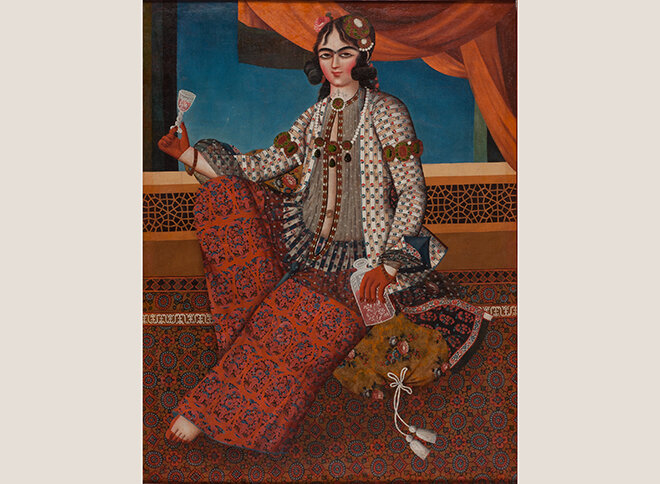 <
<
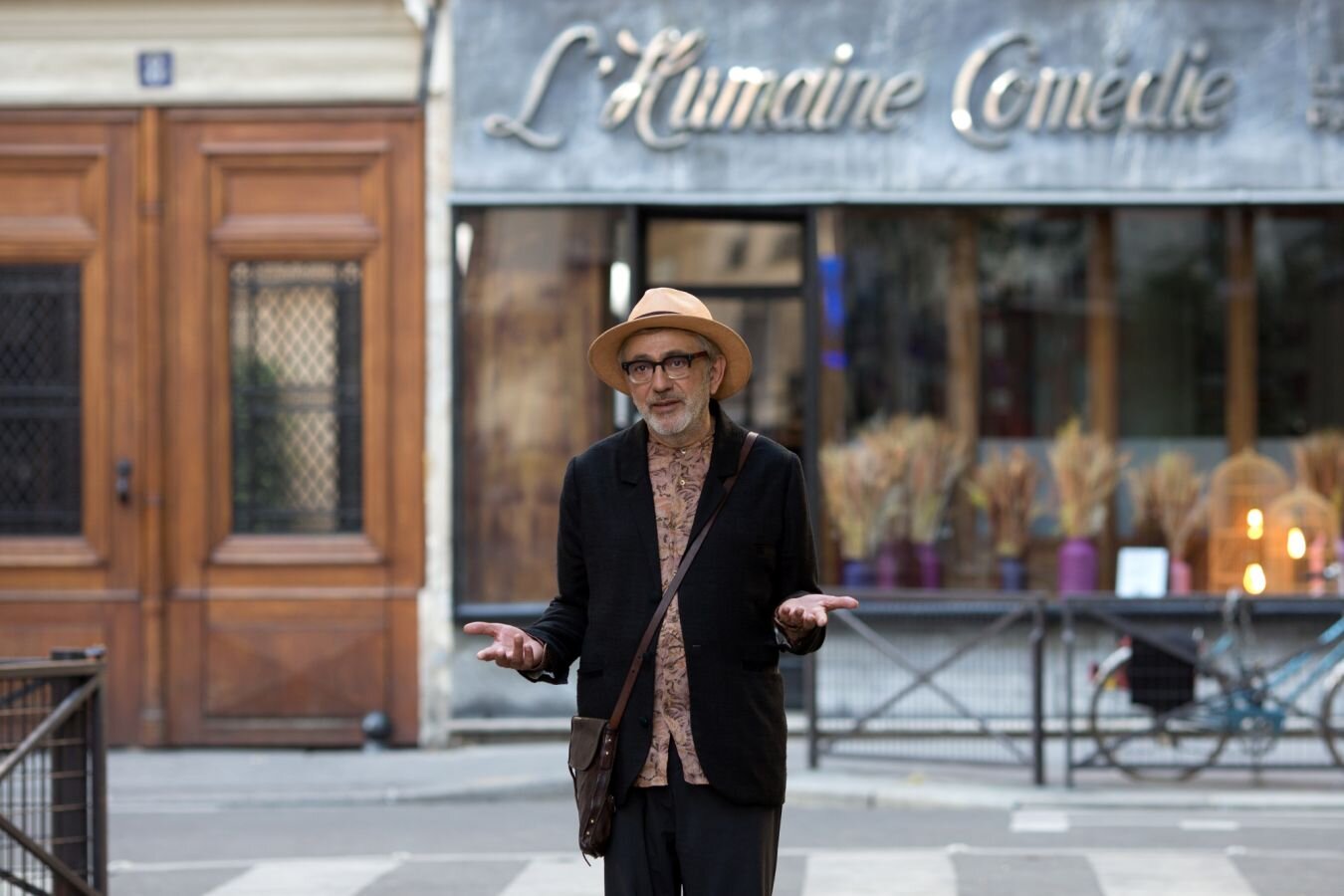 <
<
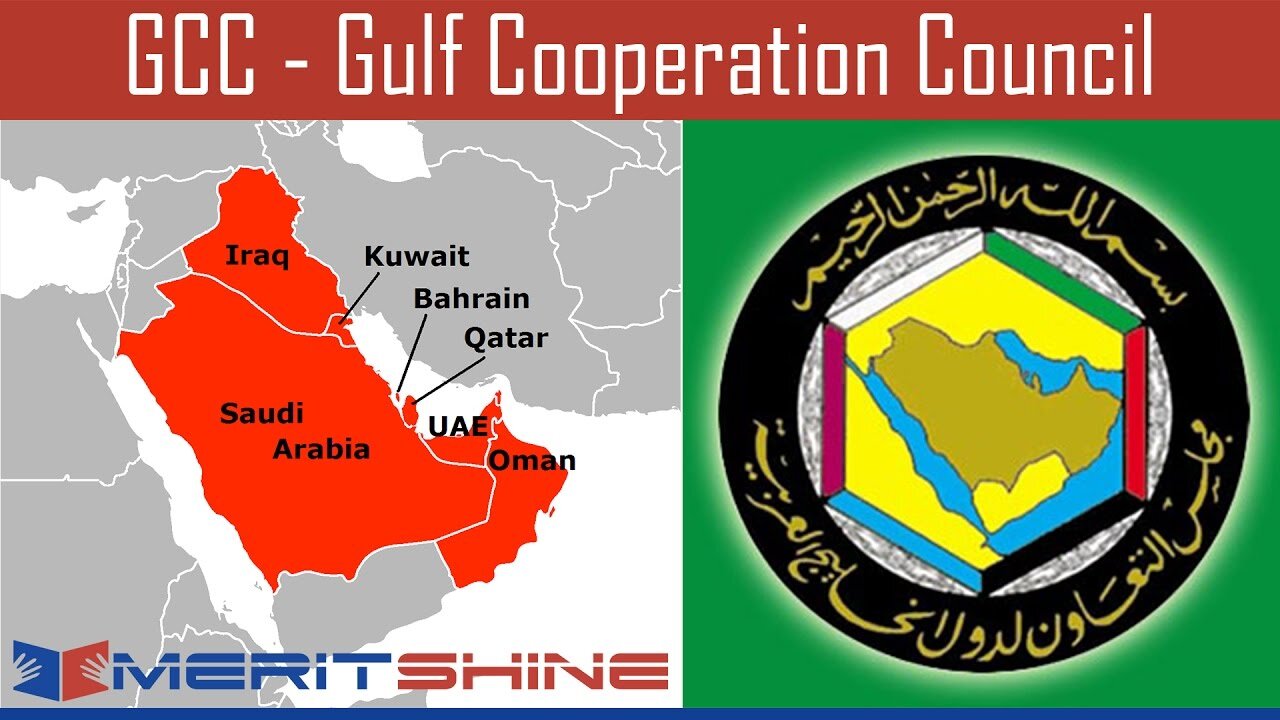 <
<
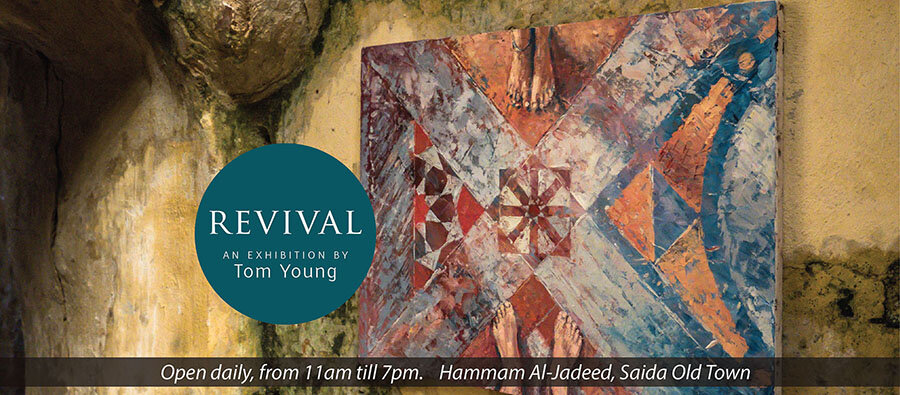 <
<
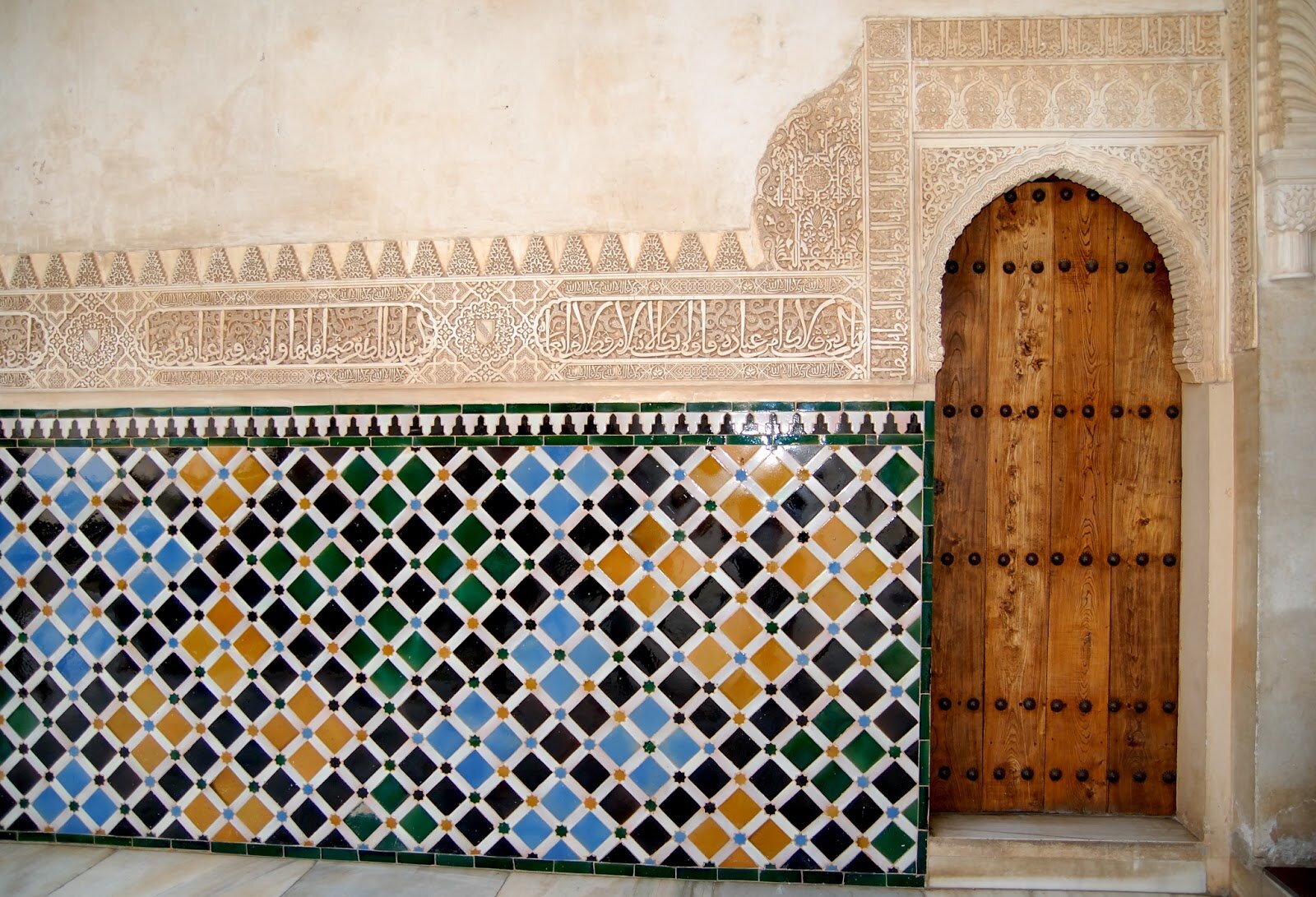 <
<
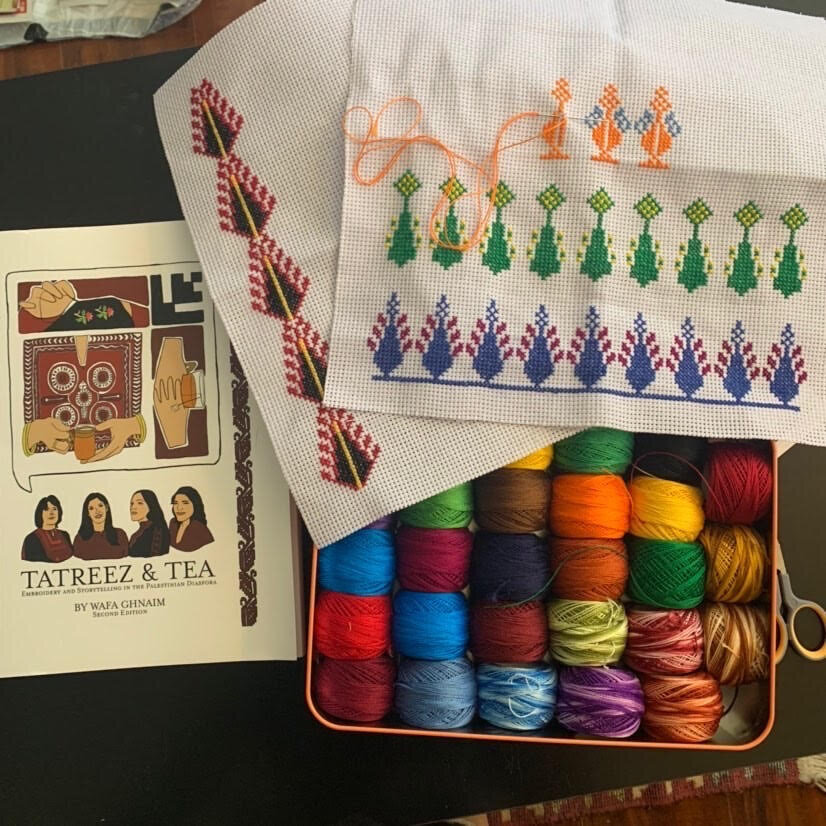 <
<
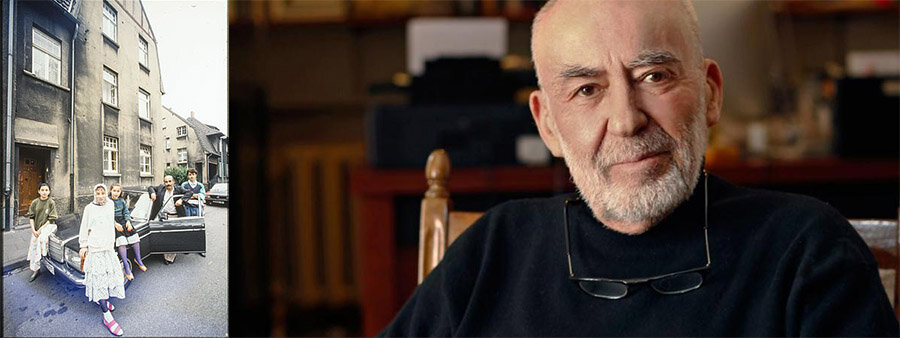 <
<
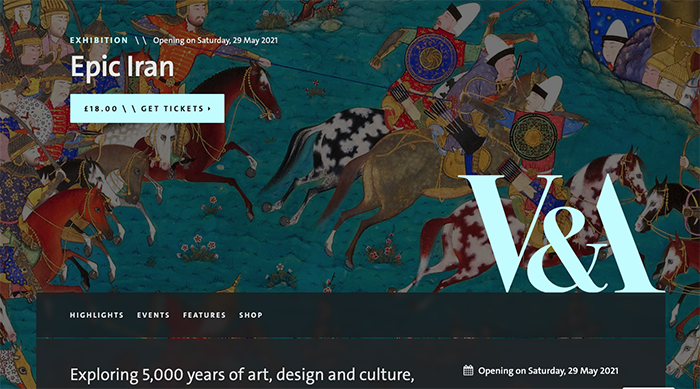 <
<

